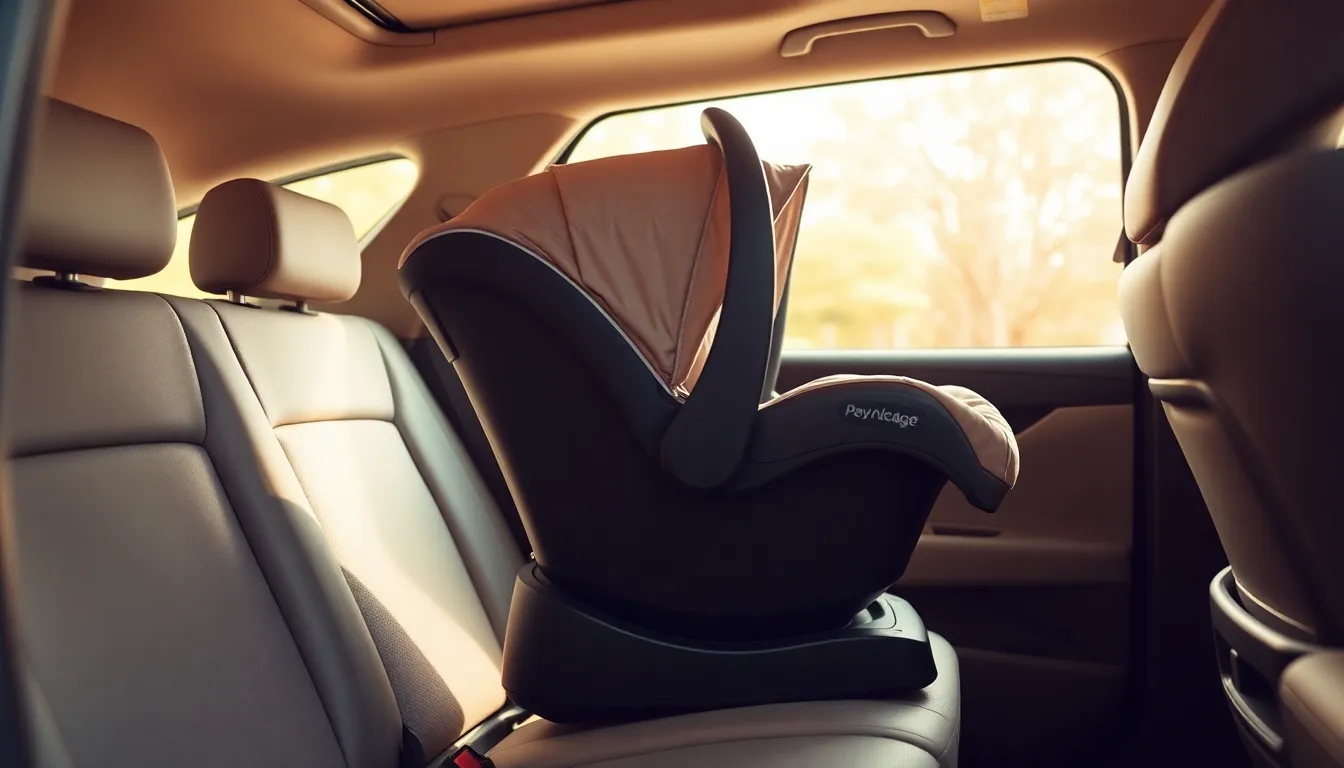Table of Contents
ToggleBringing home a newborn is like welcoming a tiny, adorable tornado into your life. Amid the chaos of diaper changes and sleepless nights, one essential piece of gear can make all the difference: the newborn car seat. It’s not just a fancy bucket for your baby; it’s a fortress of safety, designed to keep your little one snug while you navigate the wild world outside.
Choosing the right car seat can feel overwhelming. With options that range from the sleek and stylish to the downright bewildering, it’s easy to get lost in the sea of choices. But fear not! This guide will help decode the mysteries of newborn car seats, ensuring that you and your baby hit the road with confidence. Buckle up for a ride through safety features, installation tips, and everything you need to know to keep your precious cargo safe and sound.
Importance Of A Newborn Car Seat
A newborn car seat ensures safety and security during travel. It serves as a protective barrier, guarding babies against potential harm in case of an accident. Compliance with safety standards becomes essential, as these seats undergo rigorous testing to ensure their reliability.
Proper installation of a newborn car seat significantly increases its effectiveness. Many seats feature easy installation systems, including base systems and clear instructions, making it simpler for parents. A correctly installed seat reduces the risk of injury during sudden stops or collisions.
Comfort is another important aspect. Newborn car seats often include cushioned padding and adjustable features that support a baby’s delicate body. These features help ensure the newborn doesn’t experience discomfort during longer rides.
Understanding how long to use a newborn car seat is also crucial. These seats are typically suitable for infants up to 30 or 35 pounds or until they reach a specific height limit. Transitioning to a larger car seat should occur when the baby outgrows their newborn seat to maintain proper safety standards.
Parents must consider the seat’s design. Rear-facing seats provide the best protection for infants, reducing strain on the neck and spine during accidents. Many experts recommend keeping infants rear-facing for as long as possible to enhance safety.
Budgetary considerations shouldn’t overshadow safety. Investing in a high-quality, safe newborn car seat may save lives. This commitment to safety ensures peace of mind for parents during every journey.
Types Of Newborn Car Seats

Various types of newborn car seats exist to meet safety and comfort needs. Understanding these options helps parents make informed decisions.
Infant-Only Seats
Infant-only seats accommodate newborns up to 30 or 35 pounds. Designed for rear-facing travel, they provide optimal support for delicate bodies. Brands often include features like adjustable bases and easy-to-use straps. Safety standards are met through rigorous testing, ensuring peace of mind during travel. Parents appreciate the lightweight design, making transfers from car to stroller easy. Essential for newborns, these seats serve as the first line of defense in a vehicle.
Convertible Seats
Convertible seats transition from rear-facing to forward-facing as the child grows. They support infants and toddlers, typically lasting until 40 pounds in rear-facing mode and up to 65 pounds in forward-facing mode. Versatility is a key advantage of convertible seats, accommodating multiple age groups. Safety features often include side impact protection and reinforced frames. Parents value the long-term convenience, as these seats eliminate the need for purchasing additional car seats. When secure installation is ensured, these seats provide lasting protection throughout various growth stages.
Features To Look For
Selecting a newborn car seat hinges on several key features that directly impact safety and comfort.
Safety Ratings
Safety ratings play a crucial role in evaluating a car seat’s effectiveness. Industry organizations, such as the National Highway Traffic Safety Administration, evaluate seats based on accident performance and testing. A high rating indicates strong crash protection, ensuring the car seat meets rigorous safety standards. Parents should check for additional certifications like the American Society for Testing and Materials. Adherence to these safety benchmarks often highlights a seat’s reliability. It’s essential to compare different models before making a decision.
Ease Of Installation
Ease of installation greatly influences car seat effectiveness. Many modern seats include features such as LATCH systems, which facilitate swift and secure setups. A clear labeling system assists in proper attachment. Some car seats offer locking clips that enhance installation simplicity. Furthermore, several brands provide instructional videos or apps that guide parents through the installation process step by step. Choosing a model known for intuitive installation saves time and reduces the risk of improper setups.
Comfort And Support
Comfort and support directly enhance a baby’s travel experience. Look for padded inserts that cradle a newborn’s delicate body, providing stability during rides. Adjustable headrests can accommodate growth, ensuring ongoing support. Some seats feature recline angles, which are essential for minimizing head slump in tiny infants. High-quality fabrics contribute to overall comfort, ensuring the baby feels secure and relaxed. A comfortable seat can make a significant difference during longer car journeys, allowing for peaceful sleeps.
Installation Tips
Ensure proper installation of the newborn car seat for optimal safety. Read the manufacturer’s manual carefully, as each model may have unique requirements. Position the car seat in the back seat of the vehicle, following guidelines to avoid areas with active airbags.
Check the seat angle using the built-in level indicator or a bubble level for correct recline. Aim for a recline angle between 30 and 45 degrees to support the baby’s head and airway. Secure the seat tightly, with less than one inch of movement at the base when pulled at the belt path.
Utilize the LATCH system if available, which simplifies the installation process. Connect the LATCH anchors to ensure a secure fit, following the vehicle’s instructions for attachment. In cases where the seatbelt method is preferred, thread the seatbelt through the designated path and buckle it securely.
Recheck each installation step to confirm accuracy, reinforcing that safety is the priority. After securing the seat, give it a gentle shake to test tightness. Pay attention to whether the seat remains stable.
Regularly inspect the car seat for proper installation as the child grows. Consider that adjustments may be necessary due to growth or changes in the vehicle. Keeping the manual handy aids in making swift adjustments when necessary.
Maintenance And Care
Maintaining a newborn car seat ensures safety and longevity. Regularly inspect the car seat for wear, tears, or damage. Check harness systems for frays or malfunctions that might compromise safety. Cleaning the seat involves removing the cover and following manufacturer instructions. Most covers are machine washable, making it convenient to keep them fresh.
Routine cleaning prevents odor build-up and keeps the car seat hygienic. Use mild soap and water on the seat frame and harness buckles, ensuring no harsh chemicals are applied. Dry completely before reinstalling to avoid mildew. Keeping the car seat in a climate-controlled environment also prolongs its lifespan.
Storage plays a crucial role in maintenance. If not in use, storing the seat in a dry space protects against dust and debris. During travel, ensure it’s secured properly to avoid impacts that could cause damage.
Checking expiration dates is important. Most car seats have a lifespan of six to ten years. Mark the purchase date on the seat so it’s easy to track its age.
Registering the car seat with the manufacturer allows for important safety updates or recalls. Notifying parents of potential hazards ensures continued safety for their child.
Follow local regulations for car seat use as they govern the specific requirements needed for each seat’s safety features. Knowing the specifics can aid in making informed decisions regarding maintenance and care.
Choosing the right newborn car seat is an essential step in ensuring a safe and comfortable journey for both parent and baby. With various options available parents can find a seat that meets their specific needs while adhering to safety standards. Prioritizing proper installation and maintenance will enhance the car seat’s effectiveness and longevity.
Investing in a high-quality car seat not only provides peace of mind but also protects the precious life it carries. By staying informed about the latest safety features and guidelines parents can navigate the complexities of car seat selection with confidence. Ultimately this choice is about safeguarding the future and ensuring every trip is a secure one.







